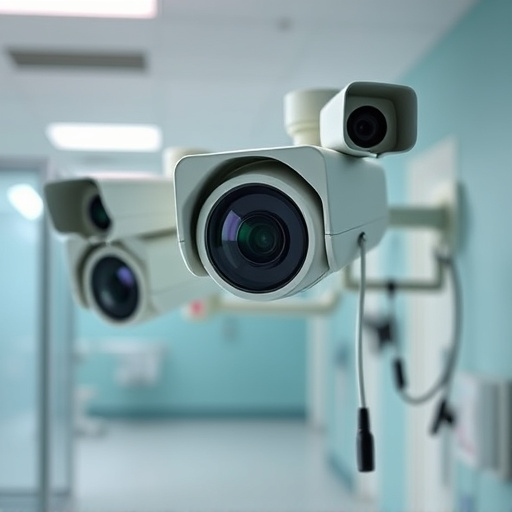Cameras in nursing homes significantly enhance resident safety and staff accountability by providing continuous monitoring, especially crucial for those with cognitive or physical impairments. They assist in activity tracking, support quality assurance through visual evidence, and enable faster emergency responses. While raising privacy concerns, proper data protection measures can balance these risks. Strategic placement, focused on high-risk areas, and transparent policies ensure confidentiality while fostering a secure environment. Advanced smart camera systems further revolutionize care by analyzing behaviors and vital signs, promising more efficient, compassionate elderly care in the future.
Elderly care monitoring is a critical aspect of ensuring safety and well-being in nursing homes. This article delves into the multifaceted world of care surveillance, specifically focusing on the role of cameras in long-term care facilities. We explore the benefits of installing cameras for elderly safety and staff accountability, while addressing ethical considerations and privacy concerns. Furthermore, we discuss best practices for implementation and emerging technologies, such as smart camera systems, that are revolutionizing elderly care monitoring. Understanding these advancements is key to optimizing care in nursing homes through the strategic use of cameras for nursing homes.
Understanding Elderly Care Monitoring: The Role of Cameras in Nursing Homes
Elderly care monitoring has evolved significantly with technological advancements, particularly in the use of cameras for nursing homes. These surveillance systems play a pivotal role in enhancing safety and security within long-term care facilities. By strategically placing cameras, nursing homes can ensure continuous observation of residents, especially those who may be at risk due to cognitive or physical impairments. This enables staff to promptly address any issues that arise, promoting a faster response time for emergencies.
The implementation of cameras in nursing homes offers multiple benefits. It not only assists in monitoring resident activities but also aids in quality assurance by providing visual evidence for assessment and auditing purposes. Moreover, these systems can serve as valuable tools for training new staff members, allowing them to observe experienced caregivers from a distance and learn best practices without direct on-site supervision. Thus, cameras for nursing homes contribute to creating a more efficient, secure, and caring environment for elderly residents.
Benefits of Installing Cameras for Elderly Safety and Staff Accountability
Installing cameras in nursing homes offers a multitude of benefits for both elderly residents’ safety and staff accountability. These surveillance systems act as a constant watchful eye, ensuring the well-being of the elderly population who may be more vulnerable to accidents, falls, or even abuse. With cameras, caregivers can promptly address any issues that arise, whether it’s assisting an elderly person in need or documenting and investigating suspicious activities.
Moreover, cameras for nursing homes serve as a powerful tool for staff training and performance evaluation. They provide visual evidence of interactions between staff and residents, promoting transparency and accountability. This technology allows supervisors to monitor care practices, ensuring they meet the high standards required in eldercare. It also aids in identifying areas for improvement and training purposes, ultimately enhancing the overall quality of care provided.
Ethical Considerations and Privacy Concerns with Camera Surveillance
Implementing cameras for nursing homes has raised significant ethical considerations and privacy concerns. While surveillance can enhance safety, ensure prompt response to emergencies, and provide peace of mind for families, it also invites potential misuse and invasion of residents’ personal space. The primary challenge lies in balancing the benefits of monitoring with respect for individual privacy and autonomy.
Privacy advocates argue that constant camera surveillance can lead to a loss of dignity for elderly residents, especially if footage is accessed or shared without their consent or proper safeguards. Additionally, there’s a risk of over-medication or unwanted interventions based on seemingly normal activities captured on camera, further complicating the ethical dilemma. Effective strategies involve stringent data protection measures, transparent policies, and clear guidelines on who has access to the footage, ensuring that privacy rights are upheld even in the interest of care monitoring.
Best Practices for Implementing Cameras in Long-Term Care Facilities
Implementing cameras in long-term care facilities, often referred to as nursing homes, can significantly enhance resident safety and well-being. Best practices dictate that these surveillance systems be strategically placed, focusing on high-risk areas like common spaces, dining halls, and corridors. The primary goal is not to intrude but to provide a layer of security and peace of mind for both residents and their families.
Privacy should be a top concern. Cameras should capture only necessary footage, with clear signage indicating their presence. Regular reviews of recorded data, limited access to video feeds, and encryption measures can ensure the confidentiality of residents’ personal moments. Staff training on camera usage and ethical surveillance practices is essential to maintaining trust and respecting individual privacy.
Emerging Technologies: Enhancing Care Monitoring with Smart Camera Systems
Emerging technologies, particularly smart camera systems, are revolutionizing elderly care monitoring in nursing homes. These advanced cameras go beyond traditional surveillance by capturing not just visual data but also analyzing behaviors and vital signs. With artificial intelligence (AI) integration, they can detect falls, assess mobility, and even identify changes in mental state, enabling caregivers to respond promptly.
Smart camera systems offer continuous, non-intrusive monitoring, providing peace of mind for both residents and their families. They collect data that can be used to tailor care plans, improve quality of life, and enhance overall safety. As technology advances, cameras for nursing homes are becoming more sophisticated, promising a future where elderly care is not only more efficient but also more compassionate.
